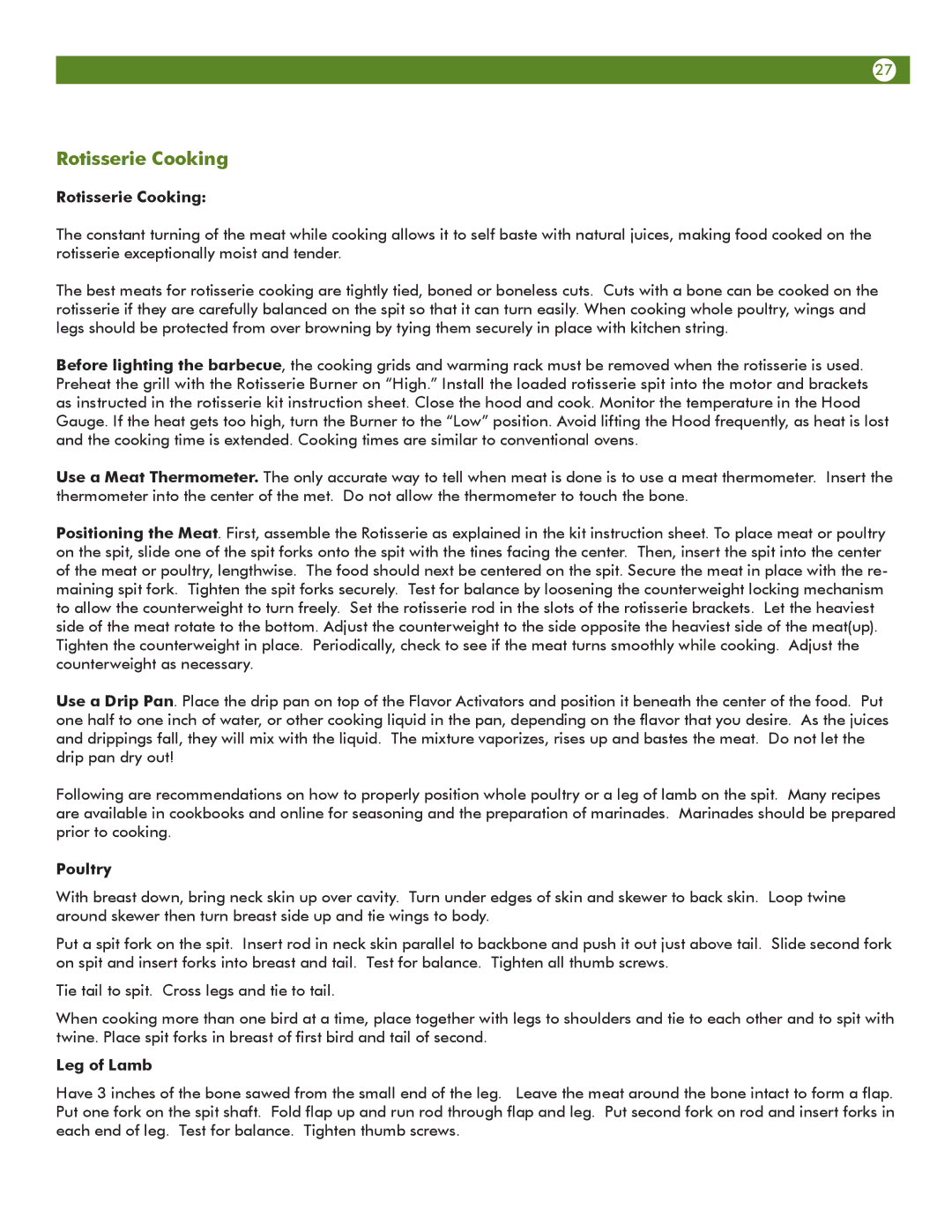27
Rotisserie Cooking
Rotisserie Cooking:
The constant turning of the meat while cooking allows it to self baste with natural juices, making food cooked on the rotisserie exceptionally moist and tender.
The best meats for rotisserie cooking are tightly tied, boned or boneless cuts. Cuts with a bone can be cooked on the rotisserie if they are carefully balanced on the spit so that it can turn easily. When cooking whole poultry, wings and legs should be protected from over browning by tying them securely in place with kitchen string.
Before lighting the barbecue, the cooking grids and warming rack must be removed when the rotisserie is used. Preheat the grill with the Rotisserie Burner on “High.” Install the loaded rotisserie spit into the motor and brackets as instructed in the rotisserie kit instruction sheet. Close the hood and cook. Monitor the temperature in the Hood Gauge. If the heat gets too high, turn the Burner to the “Low” position. Avoid lifting the Hood frequently, as heat is lost and the cooking time is extended. Cooking times are similar to conventional ovens.
Use a Meat Thermometer. The only accurate way to tell when meat is done is to use a meat thermometer. Insert the thermometer into the center of the met. Do not allow the thermometer to touch the bone.
Positioning the Meat. First, assemble the Rotisserie as explained in the kit instruction sheet. To place meat or poultry on the spit, slide one of the spit forks onto the spit with the tines facing the center. Then, insert the spit into the center of the meat or poultry, lengthwise. The food should next be centered on the spit. Secure the meat in place with the re- maining spit fork. Tighten the spit forks securely. Test for balance by loosening the counterweight locking mechanism to allow the counterweight to turn freely. Set the rotisserie rod in the slots of the rotisserie brackets. Let the heaviest side of the meat rotate to the bottom. Adjust the counterweight to the side opposite the heaviest side of the meat(up). Tighten the counterweight in place. Periodically, check to see if the meat turns smoothly while cooking. Adjust the counterweight as necessary.
Use a Drip Pan. Place the drip pan on top of the Flavor Activators and position it beneath the center of the food. Put one half to one inch of water, or other cooking liquid in the pan, depending on the flavor that you desire. As the juices and drippings fall, they will mix with the liquid. The mixture vaporizes, rises up and bastes the meat. Do not let the drip pan dry out!
Following are recommendations on how to properly position whole poultry or a leg of lamb on the spit. Many recipes are available in cookbooks and online for seasoning and the preparation of marinades. Marinades should be prepared prior to cooking.
Poultry
With breast down, bring neck skin up over cavity. Turn under edges of skin and skewer to back skin. Loop twine around skewer then turn breast side up and tie wings to body.
Put a spit fork on the spit. Insert rod in neck skin parallel to backbone and push it out just above tail. Slide second fork on spit and insert forks into breast and tail. Test for balance. Tighten all thumb screws.
Tie tail to spit. Cross legs and tie to tail.
When cooking more than one bird at a time, place together with legs to shoulders and tie to each other and to spit with twine. Place spit forks in breast of first bird and tail of second.
Leg of Lamb
Have 3 inches of the bone sawed from the small end of the leg. Leave the meat around the bone intact to form a flap. Put one fork on the spit shaft. Fold flap up and run rod through flap and leg. Put second fork on rod and insert forks in each end of leg. Test for balance. Tighten thumb screws.
